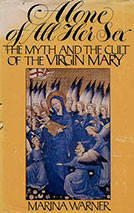

By James Dempsey
Worcester, MA, USA

James Dempsey
I read Marina Warner's Alone of All Her Sex some years ago, and was enthralled by it. The book is a study of the mother of Jesus and relates how this woman, who is only glancingly mentioned in the New Testament (and at times with some derision, even from Jesus himself), came to be such a powerful and iconic figure in the Church down through the ages. I had long lost what religion I ever had, but I found the subject fascinating and Warner's treatment of it exciting.
Warner's method is to dig into politics, history, art, religion, and literature to uncover the hidden forces that combine to create and then sustain a myth. This approach may seem iconoclastic, in that it looks for answers beyond the personal attributes of the person being studied, no matter how great those might be, but, for me, the result is a better understanding of why certain myths take hold and others do not.
I'm now enjoying Warner's Joan of Arc, another study of an iconic female, also a virgin, also a tragic figure. Warner again mines her material to explain the creation of a heroine who was as large and important, in her way, as the Virgin Mary. True, the Maid of Orleans had sterling personal qualities: she was hugely self-confident, was full of dauntless physical and psychological courage, and enjoyed a towering faith, but Warner implies that these qualities alone are not enough to understand the phenomenon that was Joan of Arc. The book answers the question of how an ordinary teenage girl in medieval France, with no aristocratic blood and no connections with power, rose to become such an important figure of her age. Further, Warner goes beyond this to ask more knotty questions: Why was she, so soon after being revered as the savior of France, damned as a heretic and burned at the stake? And further yet, why did her star once again rise so after her death, taking her into sainthood and into the top echelon of female cultural figures?


The real answers to all these questions, Warner implies, lies not only in the person of the subject we are studying, but also in us, the audience, and the common worldviews and mindsets we bring to our understandings of the narratives the world presents to us. As Warner writes, "when a story is told, it is told according to the perceptions of its hearers or its readers."
The book opens with a horrific image—the executioner at Rouen raking back the coals to display to the crowd Joan's lifeless body, the clothes all burned away to show her nakedness, before freshly stoking the fire to incinerate her remains. The onlookers would have seen before them neither a saint nor a devil, but simply a girl.
The act of taking in information by watching, reading, or hearing is too often seen as a kind of passive receptivity, the mind being a tabula rasa upon which the narrative is played. Warner's books demonstrate that what we bring to the stories of our world is as important as the substance of those stories.
Link:
James Dempsey's Profile at Stay Thirsty Publishing





